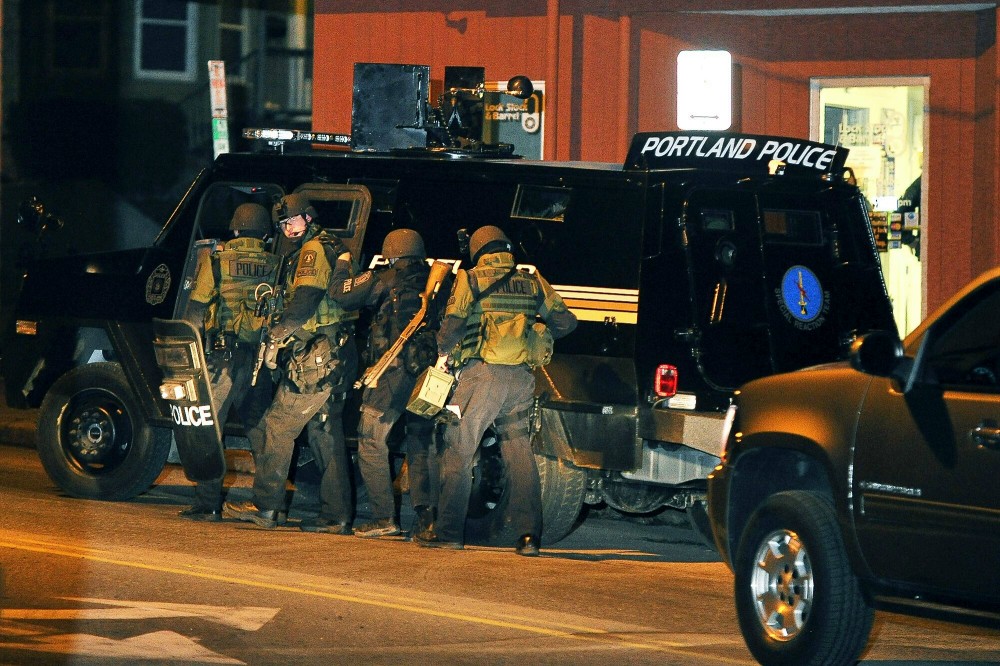PORTLAND – It was a few days before Christmas last year when Portland police got a call about a man who had made suicidal and homicidal threats during a phone conversation. After 13 hours of negotiations and several rounds of tear gas, police were finally able to take the man into custody and to Maine Medical Center for a psychological evaluation.
Patrick Mullen, 41, who reportedly displayed a handgun at one point, was subdued by police, including members of the special reaction team, who entered his apartment through a window. Mullen was later charged with terrorizing, but he was essentially unharmed.
Despite the high potential for violence, no one got hurt. The incident shows how police can use time, training and tactics to lower the need for deadly force, said Michael Sauschuck, Portland’s police chief.
“We know communications is king, and we try to do that to the best of our ability,” he said.
Portland was the first Maine police department to embrace Crisis Intervention Team training, which teaches officers how to identify people with mental health problems and de-escalate violent behavior. As of this month, 107 of the city’s 155 officers have completed the program, roughly 70 percent. Others are expected to take the 40-hour course next year.
In addition, the U.S. Department of Justice has selected Portland as one of six national learning sites on police responses to mental health situations. That allows Portland to act as a consultant and offer technical assistance to departments across the country seeking to expand their mental health response capability.
In 2011, Portland police responded to 74 technical assistance requests from police departments, universities and mental health agencies across the country, according to the chief. Contact come through email, phone calls and in-person presentations. Topics included information sharing, training, program design, policy and procedure, and program sustainability.
In the Mullen case, police were called in the late afternoon to an apartment on Washburn Street, near St. John Street. Mullen was uncooperative when officers contacted him and reportedly made threats about blowing up the building and burning it to the ground. Police cordoned off the area and brought in an armored vehicle, as well as a special response team clad in body armor and carrying rifles.
The details of how police resolved the issue are contained in an internal report that is confidential. Police declined to release it for fear of revealing tactical information to the public, and Sauschuck said he’s limited in what he can say.
But in general, Sauschuck said the trend in handling similar standoffs is to use a so-called “breach and hold” strategy. This method has police setting a perimeter, announcing their presence and breaching an entry point, but not entering the residence. They hold their position and clear the threat methodically.
“We try to negotiate to failure,” Sauschuck said. “If time is on your side, you settle in and use all your tactics and techniques.”
In choosing those tactics, responders work through a “threat matrix” that can include the suspect’s personal history, such as substance abuse, the presence of a weapon and risks to public safety. Tactics can change quickly, depending on how the suspect reacts. The use of tear gas, Sauschuck said, can signal that communication is failing or the situation is getting worse.
Sauschuck also responded to anonymous critics who posted comments on the Portland Press Herald’s website where an account of the incident was published. They questioned whether the armored vehicle and heavily armed reaction team were an overreaction on Washburn Street. This equipment is rarely used, Sauschuck said, but stands ready if needed for public safety.
The critical element in this case seemed to be time, with police holding their positions overnight in rain and snow. It’s a high-stress environment, Sauschuck said, but the fact that no one was hurt made it worthwhile.
“After 13 hours, it worked out for everybody’s benefit,” he said. “I see it as a positive outcome.”
Send questions/comments to the editors.




Comments are no longer available on this story